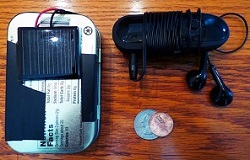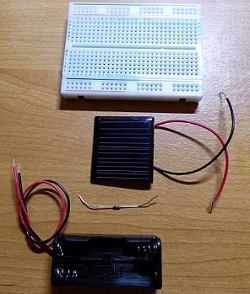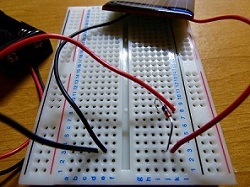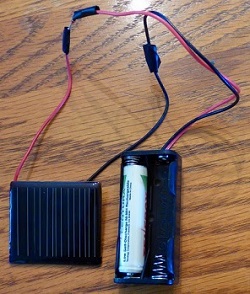Solar charger

Constructing a solar-powered charging station to recharge AAA batteries will keep an mp3 player from requiring frequent battery replacement.
Rechargeable battery specifications:
800mAh: 800 milli Ampere hours
1.2 Volts

The solar cell pictured above has a maximum current of 30mA. Printed on the AAA 1.2V rechargeable battery, you will see the capacity label (800mAh).
mAh stands for milli-Ampere-hours and indicates how much electric charge the battery provides. Ah (Ampere-hour) is defined as a unit quantity of electricity equal to the quantity carried past any point of a circuit in one hour by a steady current of one ampere. If discharging the battery through a circuit that requires 1 milli-Ampere of current, the battery will last 800 hours before the battery is completely discharged. If discharging the battery through a circuit that requires 1 Ampere, the battery will last 48 minutes (0.8x60). A single AAA battery within the mp3 player discharges after approximately 8 hours. It is likely the mp3 player circuit requires 100 milli-Amperes of current.
The Nobel Prize in Physics 1921 was awarded to Albert Einstein for his services to theoretical physics and discovery of the law of the photoelectric effect (1905). The photoelectric effect is the discovery that electrons are released when light is shined on certain metals. The discovery led to the quantum revolution and influenced the concept of the wave-particle duality.
The solar cell (made of the common metalloid silicon) converts light energy into electricity by using the photovoltaic effect. When light contacts the surface, electrons absorb energy, become excited, jump to the conduction band and become free. Some reach the junction where they generate electromotive force and are converted into electric energy.
Solar cells absorb light photons (solar or artificial), form excitons or electron-hole pairs, separate charge carriers of opposite types, and separate extraction of the charge carriers to an external circuit.
An exciton is a bound state of an electron and an electron hole which are attracted to each other by the electrostatic Coulomb force.
Increased efficiency in a solar cell can be gained by focusing on:
Reflectance efficiency (Light trapping, antireflection coating)
Thermodynamic efficiency
Charge carrier separation efficiency
Conductive efficiency
When a solar cell is exposed to light, a current flows from the solar cell via a diode through the batteries and back to the solar cell. The charge will depend on the amount of light that reaches the solar cell. Allowing the current to pass in only one direction, the diode prevents the batteries from discharging while connected to the "charging station".
1. Breadboard for prototyping electronics
2. Solar cell (30mA)
3. BAT85 Diode
4. Battery holder for two (AAA 1.2V Rechargeable)
5. Two discharged AAA Ni-MH 800mAh 1.2V rechargeable batteries
6. Small box
7. Rubber band

1. Negative for battery holder plugged into D3.
2. Positive for battery holder plugged into L8.
3. Negative for solar cell plugged into E3.
4. Positive for solar cell plugged into K3.
5. Negative for BAT85 diode plugged into J8. Negative is the wire coming from the black part of the diode.
6. Positive for BAT85 diode plugged into J3.

A warning label on each battery states: "CAUTION: BATTERY CAN EXPLODE OR CAUSE BURNS IF OVERCHARGED, DISASSEMBLED OR EXPOSED TO FIRE. DO NOT MIX WITH USED OR OTHER BATTERY CHEMISTRIES (ALKALINE, LITHIUM)." As an added precaution, the battery holder has been placed inside a small, metal box (not visible) strapped to the breadboard with a rubber band.
The charging station was placed with the solar cell facing the sun for 4 hours. After facing the sun for 4 hours, the (previously discharged) battery registered a charge on the mp3 player's charge indicator and provided over an hour of playing power to the mp3 player.
With the prototype returning positive results, the charging station is refined by removing the breadboard. The positive wire from the solar cell is connected to the BAT85 diode positive. The BAT85 diode negative is connected to the positive wire on the battery holder. The negative wire from the solar cell is connected to the negative wire on the battery holder.

With the circuit complete, double-sided tape and electrical tape is used to attach the circuit to a box. The solar cell is attached to the outside while the diode and battery holder is attached to the inside of the box.
The solar-powered battery charging station is pictured with the mp3 player.

Copyright © Oproot Research. All rights reserved.
Permission is granted for limited, non-commercial use of text and images. If used, please credit and notify Oproot Research. If circumstances permit, please include the URL: //oproot.com. Oproot Research would appreciate a copy of publication. High-resolution images are also available. Please email requests, comments to tech@oproot.com.

